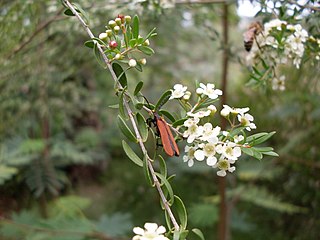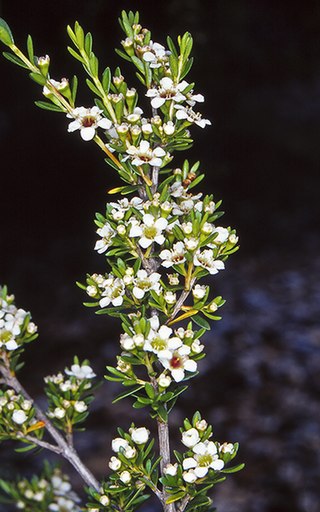
Bauera sessiliflora, also known as Grampians bauera, is a species of flowering plant in the family Cunoniaceae and is endemic to the Grampians region in Victoria, Australia. It is a scrambling shrub with wiry branches, trifoliate leaves and pink or magenta flowers.

Grevillea microstegia, commonly known as Mount Cassell grevillea, is a species of flowering plant in the family Proteaceae and is endemic to Victoria in Australia. It is a prostrate to low-lying or straggling shrub with deeply divided leaves, the end lobes triangular, and toothbrush-shaped clusters of reddish-brown flowers with a red style.

Thryptomene micrantha, commonly known as ribbed thryptomene, is a species of flowering plant in the family Myrtaceae and is endemic to south-eastern Australia. It is a spreading to erect shrub with egg-shaped leaves, the narrower end towards the base, and white flowers with five petals and five stamens.

Pimelea flava is a species of flowering plant in the family Thymelaeaceae and is endemic to south-eastern Australia. It is a shrub with narrowly elliptic to egg-shaped leaves arranged in opposite pairs, and compact clusters of 9 or more flowers with 2 or 4 elliptic to circular involucral bracts at the base. The flowers and bracts are white or yellow, depending on subspecies.

Boronia muelleri, commonly known as the forest boronia or pink boronia, is a flowering plant that occurs in forest, woodland and heath in Victoria and New South Wales in Australia. It is an erect, woody shrub or small tree with pinnate leaves and up to fifteen pink to white four-petalled flowers arranged in leaf axils in spring and summer.

Grevillea gariwerdensis is a species of flowering plant in the family Proteaceae and is endemic to Grampians National Park in Victoria, Australia. It is a shrub with more or less linear to narrowly oblong leaves, and white to pink flowers with brownish hairs.

Goodenia macmillanii, commonly known as pinnate goodenia, is a species of flowering plant in the family Goodeniaceae and is endemic to Victoria, Australia. It is an erect, short-lived perennial shrub with lyrate or lobed leaves, egg-shaped to elliptic in outline with toothed edges, and leafy racemes of bluish-purple flowers.

Grevillea dimorpha, commonly known as flame grevillea or olive grevillea, is a species of flowering plant in the family Proteaceae and is endemic to the Grampians National Park in Victoria, Australia. It is an erect to spreading shrub with elliptic to linear or egg-shaped leaves with the narrower end towards the base, and groups of bright red flowers.

Grevillea jephcottii, commonly known as Pine Mountain grevillea, green grevillea or Jephcotts grevillea is a species of flowering plant in the family Proteaceae and is endemic to a restricted area of Victoria. It is a low dense, to tall spindly shrub with narrowly oblong to narrowly elliptic leaves, and clusters of pale lemon or greenish flowers with a purplish style.

Grevillea confertifolia, commonly known as Grampians grevillea or dense-leaf grevillea, is a species of flowering plant in the family Proteaceae and is endemic to the Grampians in Victoria, Australia. It is a spreading, often dense shrub with linear to narrowly oblong leaves, and reddish-purple flowers.

Baeckea brevifolia is a species of flowering plant in the family Myrtaceae and is endemic to south-eastern New South Wales. It is a shrub with narrow egg-shaped to oblong leaves and white to pink flowers with nine to fifteen stamens.

Thryptomene saxicola, commonly known as rock thryptomene, is a species of flowering plant in the family Myrtaceae and is endemic to the south-west of Western Australia. It is a spreading shrub with small oval or egg-shaped leaves and pale pink flowers arranged in leaf axils. It is hardy plant, common in cultivation, sometimes as "Payne's hybrid" or Thryptomene paynei.

Gaudium jingera, commonly known as the stringybark tea-tree, is a species of shrub that is endemic to Victoria, Australia. It has papery bark on the larger branches, smooth bark on the younger stems, narrow egg-shaped to elliptical leaves, white flowers and silky-hairy, hemispherical fruit.

Sannantha pluriflora, commonly known as tall baeckea, is a species of flowering plant in the myrtle family, Myrtaceae, and is endemic to continental southeastern Australia. It is a shrub or small tree with lance-shaped to elliptic leaves, and groups of two to nine white flowers arranged in umbels in leaf axils.

Baeckea imbricata, commonly known as heath myrtle, is a species of flowering plant in the family Myrtaceae and is endemic to eastern Australia. It is a shrub with elliptical to egg-shaped or round leaves and small white flowers with five to twelve stamens.
Thryptomene eremaea is a species of flowering plant in the family Myrtaceae and is endemic to Western Australia. It is an erect shrub with upward-pointing, oval leaves and white or pale pink flowers with five petals and ten irregularly arranged stamens.
Thryptomene ericaea is a species of flowering plant in the family Myrtaceae and is endemic to South Australia. It is a shrub with narrow elliptic leaves and white flowers with five petals and five stamens.

Baeckea latifolia is a species of flowering plant in the family Myrtaceae and is endemic to south-eastern continental Australia. It is a shrub with broadly elliptic leaves and small white flowers with six to eight stamens.

Baeckea utilis, commonly known as mountain baeckea, is a species of flowering plant in the family Myrtaceae and is endemic to south-eastern continental Australia. It is a shrub with elliptic to lance-shaped leaves with the narrower end towards the base and white flowers, usually with eight stamens.

Sannantha crenulata, commonly known as fern-leaf baeckea, is a species of flowering plant in the myrtle family, Myrtaceae and is endemic to a restricted part of Victoria in Australia. It is an erect shrub with egg-shaped to round leaves with scalloped edges, and groups of usually 3 white flowers arranged in leaf axils.


















